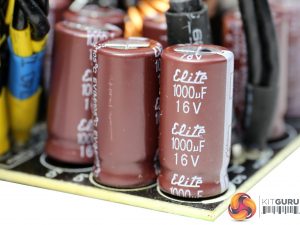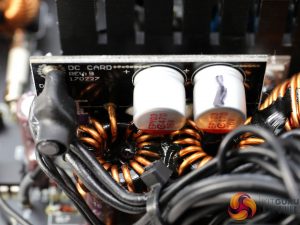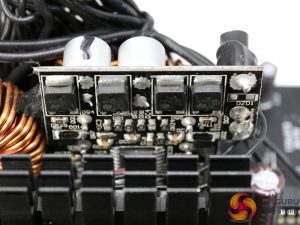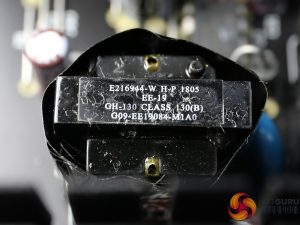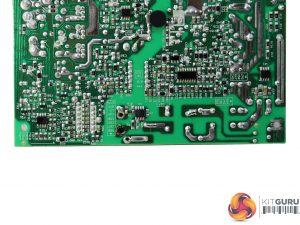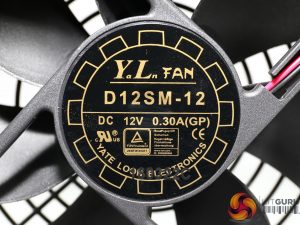| General Data | |
| Manufacturer (OEM) | CWT |
| Primary Side | |
| Transient Filter | 4x Y caps, 2x X caps, 2x CM & 1x DM chokes, 1x MOV, 1x CAP004DG Discharge IC |
| Inrush Protection | NTC Thermistor |
| Bridge Rectifier(s) |
1x
|
| APFC MOSFETS |
2x Champion GP28S50G (500 V, 28 A @ 150°C, 0.125 Ohm)
|
| APFC Boost Diode |
1x CREE C3D06060A (600V, 6A @ 154°C)
|
| Hold-up Cap(s) |
1x Elite (400V, 390uF, 2000h @ 85°C, GM)
|
| Main Switchers |
2x Champion GP28S50G (500 V, 28 A @ 150°C, 0.125 Ohm)
|
| Combo APFC/PWM Controller | Champion CM6800TX & CM03X Green PFC controller |
| Topology |
Primary side: Double-Forward topology
Secondary side: Semi-synchronous Rectification & DC-DC converters |
| Secondary Side | |
| +12V Rectifiers | 2x Sync Power SPN125T06 FETs (60V, 88A @ 70°C, 4.3mOhm) 2x PFC PFR40V60CT SBRs (60V, 20 x 2A) |
| +12V Driver IC | 1x Sync Power SP6019 |
| 5V & 3.3V | DC-DC Converters: 2x UBIQ QM3006D (30V, 57A @ 100°C, 5.5mOhm) 2x UBIQ QM3016D (30V, 68A @ 100°C, 4mOhm) PWM Controller: APW7159C |
| Filtering Capacitors | Electrolytics: Elite (3-6,000 @ 105°C, EV), 2x Rubycon (3-6,000h @ 105°C, YXG) |
| Supervisor IC | Sytronix ST9S429-PG14 (OCP [2x 12V channels, OVP, UVP, PG) & Weltrend WD7518D (OCP [2x 12V channels], SCP) |
| Fan Model | Yate Loon D12SM-12 (120mm, 12V, 0.30A, 70.5 CFM, 33 dBA, 1650 RPM, Sleeve Bearing) |
| 5VSB Circuit | |
| Standby PWM Controller | TinySwitch-LT TNY289PG (25W @ 85-265VAC) |
The platform is outdated, with the only modern touch being the DC-DC converters that generate the minor rails. Since it is a budget-oriented product, be quiet! avoided using expensive Japanese caps, even Taiwanese (Teapo).
Nonetheless, Elite caps are the best alternative when you want something way better than generic Chinese caps but you have a restricted budget.
In the primary side a double-forward topology is used. We had quite some time to meet this topology since the majority of modern platforms utilize half-bridge and full-bridge topologies along with LLC resonant converters, a combination offering increased efficiency compared to the older double-forward configurations.
In the secondary side a semi-synchronous design is used with two FETs and two SBRs handling the +12V rail.
The first part of the EMI filter is on the AC receptacle and includes two Y caps and a single X one. The same filter continues on the main PCB with the same amount of Y and X caps, two CM and one DM chokes, and an MOV.
There is also a CAP004DG discharge IC on the solder side of the PCB, which isolates the bleeding resistors of the X cap once the power supply is in normal operation, saving energy.
The single bridge rectifier is bolted on a dedicated heatsink. There is enough thermal paste as you can see in the photo above, between the rectifier and the heatsink.
The APFC converter uses two Champion GP28S50G FETs and a single CREE C3D06060A boost diode. The bulk cap is by Elite and unfortunately it is only rated at 85°C. A Japanese cap with 105°C rating should be used instead since the cost would be slightly affected (less than a dollar difference).
With a higher quality cap in this stage the reliability through time would be way better, especially in regions with 100-115V voltage and difficult conditions (heat and unstable mains grid).
The NTC thermistor which is responsible for protection against large inrush currents. It isn't supported by a bypass relay, unfortunately.
The main switching FETs are two Champion GP28S50G, arranged into a double-forward topology.
The combo PFC/PWM controller is a CM6800TX IC, which was widely used a few years ago in Bronze, Silver, even in some 80 PLUS Gold platforms. It is supported by a CM03X Green PFC controller.
The unit's main transformer, which besides lowering the voltage also provides electrical isolation between the primary and the secondary sides.
The +12V rail is rectified by two Sync Power SPN125T06 FETs and two PFC PFR40V60CT SBRs. The driver IC for the aforementioned FETs is a Sync Power SP6019.
The filtering caps are mostly provided by Elite and they are of good quality, although they are not made in Japan but in China. The specifications are higher compared to Chemi-Con's KZE caps, which are omnipresent in more expensive power supplies.
Both minor rails are generated through a pair of DC-DC converters, installed onto a small daughter-board. The switching FETs are two UBIQ QM3006D and two UBIQ QM3016D and the common PWM controller is a APW7159C.
The standby rail's PWM controller is a TinySwitch-LT TNY289PG. This is a modern controller, usually found in higher-end platforms.
There are two supervisor ICs, a Sytronix ST9S429-PG14 and a Weltrend WD7518D. Since this unit only has two virtual +12V rails, most likely there was no need for the Weltrend IC.
The soldering quality is not the best we have seen from CWT, but it is good enough for a budget platform.
The cooling fan is by Yate Loon and it uses a sleeve bearing. We would like to see a rifle bearing used, instead. It measures 120mm across and it is controlled by a highly relaxed speed profile.
 KitGuru KitGuru.net – Tech News | Hardware News | Hardware Reviews | IOS | Mobile | Gaming | Graphics Cards
KitGuru KitGuru.net – Tech News | Hardware News | Hardware Reviews | IOS | Mobile | Gaming | Graphics Cards
























